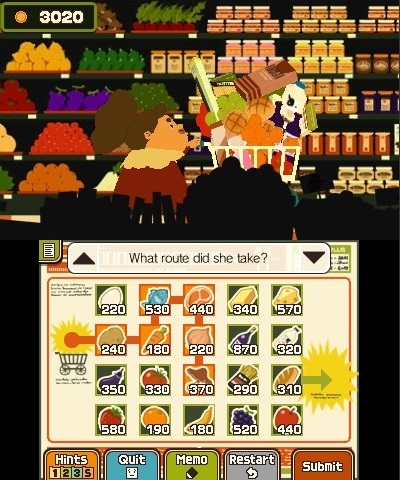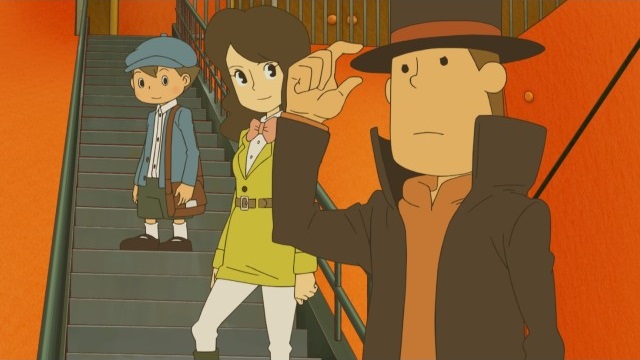The answer is 37. That's how many "puzzles" there are in this review.
As it stands, I’m not going to tell fans anything majorly surprising about Professor Layton and the Azran Legacy that you can’t already imagine. In what is apparently the namesake’s final adventure as the lead protagonist, this finale to the prequel trilogy offers exactly everything you may expect of a Professor Layton game. For those entering without specific expectations, I will expound further.
In what can only be a described as an alternate universe, people are obsessed with puzzles. When the gravelly-voiced Layton, the animal-whispering Luke, or photo-happy Emmy make any sort of inquiries among the peoples of their world—be it to ask for directions, the identity of a particular person, or the antidote—they give them puzzles to solve. Many of the denizens of the locales you visit, including Bizarro London, are inexplicably stuck in life, unable to eat or sleep, until Layton and crew come to solve their puzzles. Puzzles free them, but puzzles enchain them.
These puzzles run the gamut as far as brainteasers go: recognizing patterns, logic grids, staring at a scene and choosing the right answer, rearranging pieces, etc. Some are straightforward, and others require thinking outside of the box. Solving puzzles nets you picarats, which have no real-world counterpart and do nothing for you during the main game and only reward you after completion.
As you play, though, you unlock the Nutty Roller, Bloom Burst, and Dress Up variety of puzzles, which are all entertaining in their own right. To put it simply, when you tire of solving the game’s puzzles, it has other puzzles for you to solve. When you finish, even more puzzles unlock, including daily downloadable puzzles. The total is in the 500s, with 150 of the “normal” puzzles being contained in the main game. Needless to say, you must enjoy solving puzzles to play this game. There is absolutely no way around it.
The story wrapped around these puzzles is, for the most part, unsurprising in its execution. "Profezzor Puzzle" games capitalize on how charming the rest of the world finds the British. This story in particular is chock full of mildly brow-raising but otherwise inoffensive Anglocentrism. This manifests during a more “open” section of the game that allows you to venture to various, I’d say, undeveloped parts of the world, where our heroes liberate the English-speaking residents of jungles and walled cities of their maladies. Regardless of how primitive or advanced the people seem, they are all still just as fascinated with puzzles. Puzzles bind them together, but puzzles also set them apart.

The Azran Legacy itself is the main narrative’s MacGuffin—the technology of the ancient Azran peoples is touted as the source of many myths, and coming into contact with their defrosted messenger sets the team off on a worldly adventure.
Although I appreciate the maniacal genius behind all these puzzles, it is their alarming frequency that removes any sense of urgency from the story. No matter what is going on at any given time or how dire the circumstances, the characters of the Puzzler Puzzle and the Azran Legazy always have time to solve something. As ridiculous as this already is, the foolishness is compounded when you’re faced against enemies with guns who throw puzzles instead. Puzzles threaten, but puzzles save.
I’ll acknowledge that the end-game is ultimately more compelling than any of the colorful rearrangement of story tropes that form the bulk of the main narrative. Once you go deep into the whole Azran thing, some crazy truths are revealed, which deeply affect every single character in the game. It’s a shame that all the twists are saved for the end of this 16-hour journey (assuming you don’t stop for every puzzle), but they resulted in an ending that tugged at more than a few of my cold, cold heartstrings.

Luckily, the presentation of this odd story puzzle thing is practically flawless. All the environments are so detailed and beautifully rendered that it’s an absolute treat to explore each scene with your stylus. Doing so nets you collectible objects, coins to spend on hints, and even more puzzles. The 3D effect is actually superb with excellent portrayals of depth and very few gimmicks. Of course, like any other 3DS game, your eyes will probably tire of it, but it’s impressive for as long as you have it on.
The music is luscious and gorgeous, pairing well with each place the characters visit. The one exception would probably be the music that plays while you actually solve puzzles. It’s nice, but listening to it on repeat when you’re stumped or even at all by the end of the game behooves you to turn the volume down for a few minutes.
If you’re already a fan of the series, or if any of this niche game sounds appealing to you, I urge you to give Professor Layton and the Azran Legacy a try. Certainly, those who played the previous two (or five) games will want to know how the trilogy ends. For the others who are not into super English puzzle games or are barely into that section of the newspaper, there are more creatively-engaging games on the market. However, consider putting the gun down now and again. Puzzles can bring great peace, but puzzles also inspire unnerving chaos.
-
Smart, engaging puzzles...
-
...which ironically mar the story about puzzles.
-
Well, the story wasn't that great anyway...
-
...until the emotional and satisfying endgame.
-
Beautiful environments and music
-
A lot more puzzles await when you're done







